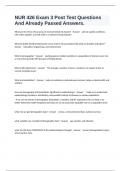Tentamen (uitwerkingen)
NUR 426 Exam 3 Post Test Questions And Already Passed Answers.
- Vak
- Instelling
What are the three critical areas of environmental risk factors? - Answer safe air quality conditions, safe water supplies, and safe soils in a nations farming industry What do public health professionals use to reduce risk associated with what we breathe and ingest? - Answer education, en...
[Meer zien]



